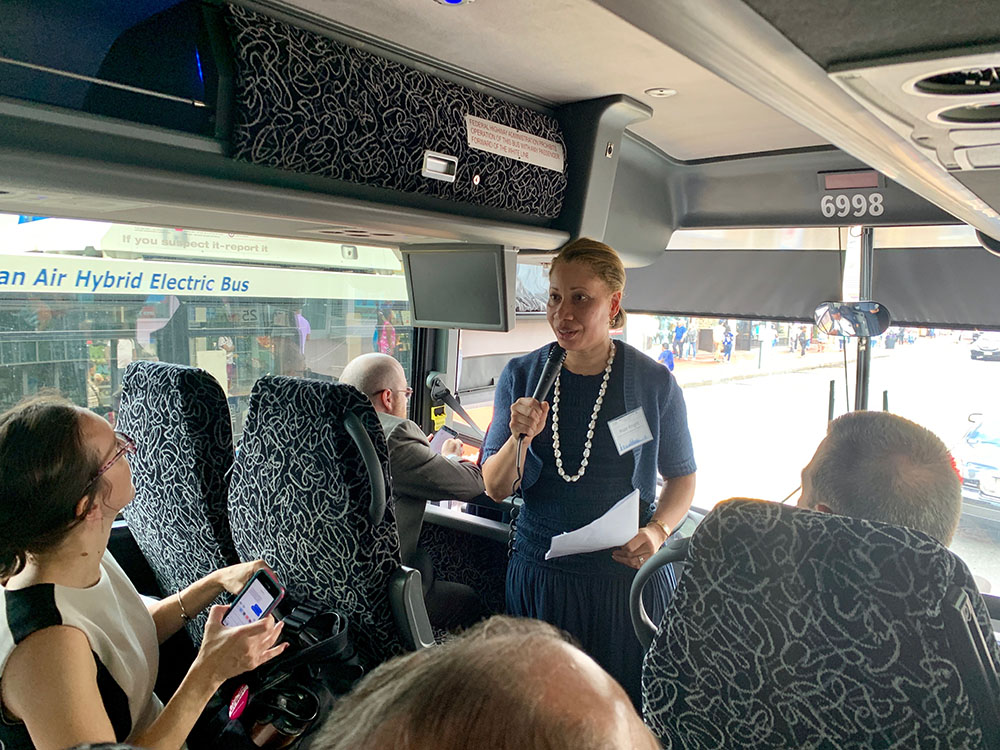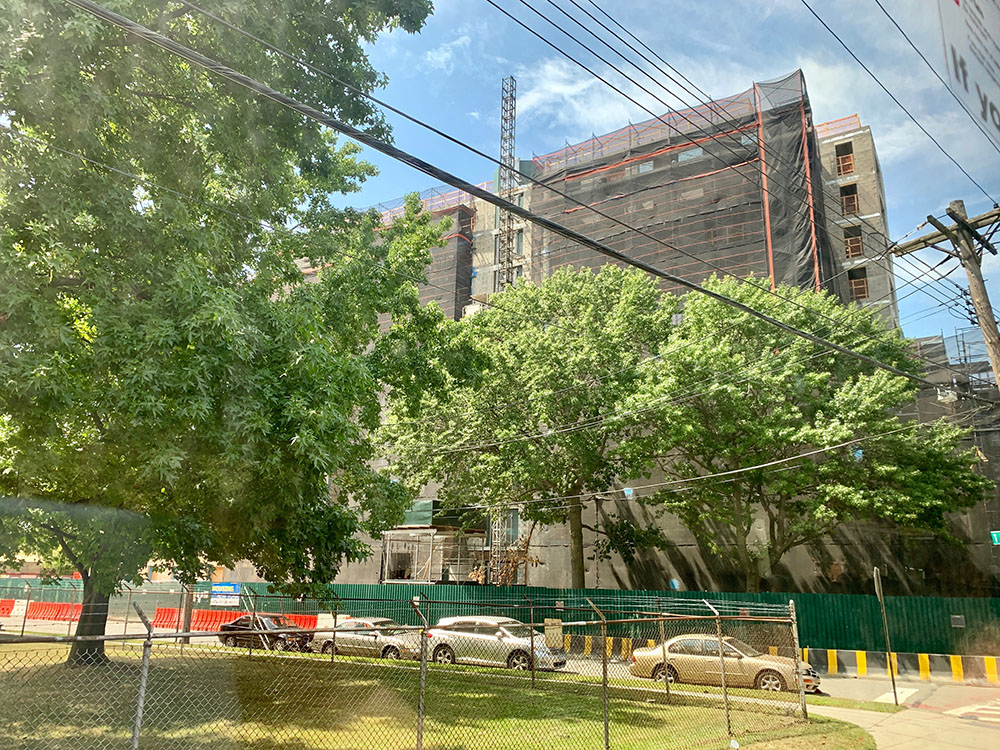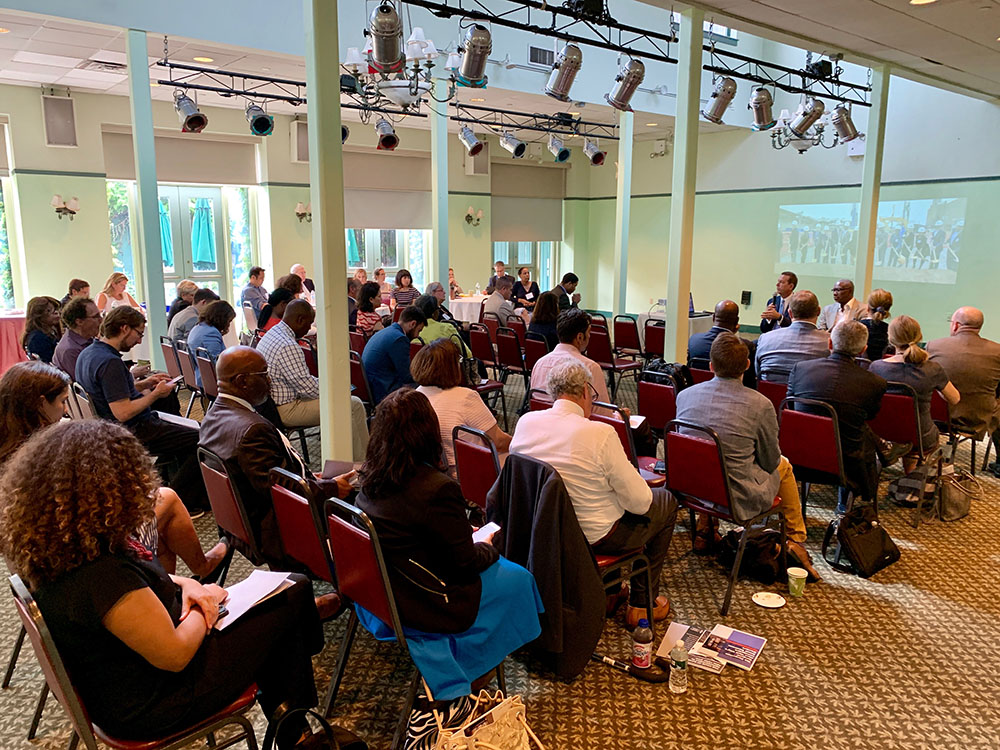Groups call on the OCC to ensure that the CRA be preserved and strengthened to better respond to local community needs
The Association for Neighborhood & Housing Development (ANHD) and its member allies led a community tour in Jamaica, Queens, with the Comptroller of the Currency Joseph Otting yesterday. As the OCC conducts tours nationwide to present its ideas for ways to reform the Community Reinvestment Act (CRA), ANHD welcomed this opportunity to demonstrate how the CRA both is and is not working for our local communities in New York City, and the ways it can be strengthened to increase access to safe, affordable housing, quality jobs, and access to banking for underserved consumers and small businesses.
ANHD’s top priorities for CRA reform include: (1) an assessment of quality, quantity, and impact on lower-income people and people of color; (2) strong mechanisms for community input; and (3) that it maintains a strong local obligation.
 ANHD and our local community groups used this opportunity to share with Comptroller Otting some of the ways the modernization process could preserve and strengthen the CRA to better meet local needs. The tour highlighted the impact strong CRA investments can have in historically low-wealth communities, especially when done in collaboration with mission-driven developers, neighborhood-based organizations, and community organizers.
ANHD and our local community groups used this opportunity to share with Comptroller Otting some of the ways the modernization process could preserve and strengthen the CRA to better meet local needs. The tour highlighted the impact strong CRA investments can have in historically low-wealth communities, especially when done in collaboration with mission-driven developers, neighborhood-based organizations, and community organizers.
“We’re pleased to have had this opportunity to show Comptroller Otting the impact of the CRA on the work of ANHD members, who include mission-driven developers, neighborhood-based organizations, and community organizers,” said Jaime Weisberg, senior campaign analyst for ANHD. “The sites and stories on the tour helped illustrate our priorities for CRA reform in order to increase access to safe, affordable housing; quality jobs; and access to banking for consumers and small businesses. We will evaluate any proposal against these principles, and urge the OCC to develop proposals together with the other regulators.”
 The tour started at Jamaica Market, a food hall and vendor space developed by the Greater Jamaica Development Corporation (GJDC) in the heart of Downtown Jamaica. The market features local vendors and receives over 15,000 visitors weekly.
The tour started at Jamaica Market, a food hall and vendor space developed by the Greater Jamaica Development Corporation (GJDC) in the heart of Downtown Jamaica. The market features local vendors and receives over 15,000 visitors weekly.
“As Downtown Jamaica blooms and attracts increasing numbers of residents, businesses, workers and visitors, the Community Reinvestment Act is one of the resources responsible for this ongoing renaissance,” said Hope Knight, president and CEO of the Greater Jamaica Development Corporation. “This would not be possible without our partners in the public and financial sectors who help us address the needs of the community, create jobs, and enhance the quality of life across all socioeconomic backgrounds in Downtown Jamaica. The CRA must be preserved and strengthened.”
The tour continued down a long corridor of Guy R. Brewer Blvd lined with homes, small businesses, and community spaces, but not one bank branch much to the dismay of the Comptroller. Meanwhile, the tour passed by numerous check cashers, pawn shops, and private ATM machines that ultimately cost the consumer fees charged by both the ATM and their bank. A short detour took us by Carver Bank, a mission-driven minority owned CDFI bank rooted in the local community.
“New Yorkers in LMI neighborhoods deserve sound financial options – this means more branches and affordable banking products so they can have opportunities to open bank accounts, build credit, buy large items like a car or a home, start a business, or obtain an education,” said Jumelia Abrahamson, director of the Northwest Bronx Resource Center at the University Neighborhood Housing Program (UNHP). “Meeting these local needs, which can be very painful or impossible to recover from, should remain at the core of CRA.”
“Banks, like the ones on this bus, are critical to supporting CDFIs like the Business Outreach Center and Greater Jamaica’s CDFI,” said Nancy Carin, the executive director of the Business Outreach Center Network and BOC Capital Corp (CDFI). “Their investments support our lending, financial counseling, and technical assistance for small businesses throughout New York City. But, CDFI’s can’t meet the needs alone – we also need banks to be lending to small businesses and hope that the CRA can incentivize that even more moving forward, especially for small-scale businesses that struggle most to access capital.”
Next, the group visited Northeastern Towers Annex, a joint venture development between ANHD member, Fifth Avenue Committee (FAC) and the Seventh Day Adventist Northeastern Conference. The development provides housing for low-income seniors earning less than 60% of the Area Median Income (AMI), including formerly homeless seniors. When talking about the purpose of the CRA, it shouldn’t just be about dollars; it should also be about impact.

 “What does impact mean?” asked Jay Marcus, the director of housing development at Fifth Avenue Committee. “The housing that is built is not only deeply and permanently affordable, but it also serves the needs of community members, and in the case of Northeastern Towers Annex, serving seniors in this community.”
“What does impact mean?” asked Jay Marcus, the director of housing development at Fifth Avenue Committee. “The housing that is built is not only deeply and permanently affordable, but it also serves the needs of community members, and in the case of Northeastern Towers Annex, serving seniors in this community.”
Following the Northeastern Towers Annex, Neighborhood Housing Services (NHS) of Jamaica discussed challenges residents face in purchasing homes and remaining in their homes, and the important role CRA-covered banks play in increasing access to home loans. The range of affordable products available and local partnerships are a direct result of the CRA, but disparities remain to be addressed.
“Were it not for the banking products as a result of the CRA, it would not be possible for our homeowners to buy their homes,” said Lori Miller, the interim executive director of NHS of Jamaica. “But, there is more banks can be doing, especially in Southeast Queens where bank branches are sparse and non-traditional lenders are prevalent. We need affordable mortgages with down payment assistance and home improvement loans to help people purchase and remain in their homes”
On the way to an industrial corridor and the former Elmhurst Diary, GJDC discussed industrial and manufacturing challenges and opportunities related to financing, zoning, and competing uses. The bus drove by warehouses, shipping companies, and other small businesses financed by GJDC. This is an example of ways CRA-covered banks can support quality jobs for underserved populations. In the outer boroughs of New York City, industrial jobs employ 80% people of color and pay double that of service sector jobs.
“Jamaica has a long industrial past that has played a significant role in the regional and local economies and will be a factor in the area’s future success,” said Aron Kurlander, director of Business Services Group at GJDC. “The CRA is crucial to providing the levels of funding needed to support the rise of modern-day industrial businesses that provide good-paying jobs for families in southeast Queens.”
 Next, the tour brought participants inside Alvista Towers, a mixed-income development in downtown Jamaica. This was one of the first developments to go up in the Jamaica rezoning with a rooftop that provides a view of downtown Jamaica and beyond, including industrial and residential sites, and an overview of future affordable housing developments. Alvista Towers has low-moderate-middle income units at 50% to 135% AMI.
Next, the tour brought participants inside Alvista Towers, a mixed-income development in downtown Jamaica. This was one of the first developments to go up in the Jamaica rezoning with a rooftop that provides a view of downtown Jamaica and beyond, including industrial and residential sites, and an overview of future affordable housing developments. Alvista Towers has low-moderate-middle income units at 50% to 135% AMI.
Near the end of the tour, the bus drove by a set of multifamily buildings owned by Zara Realty, which has been under pressure from tenants for years due to alleged harassment of rent-stabilized tenants. They were charged in May by the New York State Attorney General for violating rent stabilization laws and displacing tenants with such tactics as illegal broker fees, rent increases, and late fees.
 “Afro-Caribbean, South Asian, African-American communities helped build up Jamaica into the powerhouse it is now,” said Jagpreet Singh, tenant organizer at Chhaya CDC. “Widespread deregulation of apartments and harassing of tenants in buildings owned by groups like Zara Realty are displacing the folks who built up and revitalized this community.”
“Afro-Caribbean, South Asian, African-American communities helped build up Jamaica into the powerhouse it is now,” said Jagpreet Singh, tenant organizer at Chhaya CDC. “Widespread deregulation of apartments and harassing of tenants in buildings owned by groups like Zara Realty are displacing the folks who built up and revitalized this community.”
“We would love to find a way to hold lenders accountable through the CRA,” said Will Spisak, director of programs at Chhaya CDC. “We hope that we can think about the modern legacies – redlining, harassment, etc. – and how they are playing out in current markets.”
Finally, the tour concluded back at GJDC’s event space, the Harvest Room, where the Comptroller was joined by Rep. Gregory Meeks of the 5th Congressional District of New York to lead a discussion on CRA modernization with the attendees. The Comptroller took the opportunity to reflect upon what he saw and to answer questions about the reform process. He was particularly struck by the lack of bank branches in Jamaica and the impact that has had on the community, as well as the extremely high demand for affordable housing. He informed the participants that he expects the OCC to release a Notice of Proposed Rulemaking (NPR) by the end of September and that, while he was hopeful it would happen with the other regulators, he raised the possibility that the OCC may go it alone. He urged everyone to comment on the proposed rules about matters important to them, including an area raised by multiple participants regarding how the regulators should deal with banks financing displacement.

“When the CRA began, many communities were left out,” said Rep. Meeks to the crowd. “Some communities like this one are becoming banking deserts again. The CRA is about access to credit – we need to revitalize communities in a way that enables existing residents to stay, and we need all three regulators to be on the same page with CRA reform, to have one message.”
The CRA must be preserved and strengthened, and not weakened in any way. Banks must be evaluated on the quality, quantity, and impact of their activities within the local communities they serve and based on the needs of these local communities.